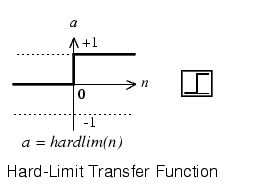

| Neural Network Toolbox |   |
Neuron Model
A perceptron neuron, which uses the hard-limit transfer function hardlim, is shown below.
Each external input is weighted with an appropriate weight w1j, and the sum of the weighted inputs is sent to the hard-limit transfer function, which also has an input of 1 transmitted to it through the bias. The hard-limit transfer function, which returns a 0 or a 1, is shown below.

The perceptron neuron produces a 1 if the net input into the transfer function is equal to or greater than 0; otherwise it produces a 0.
The hard-limit transfer function gives a perceptron the ability to classify input vectors by dividing the input space into two regions. Specifically, outputs will be 0 if the net input n is less than 0, or 1 if the net input n is 0 or greater. The input space of a two-input hard limit neuron with the weights  and
and a bias  , is shown below.
, is shown below.
Two classification regions are formed by the decision boundary line L at  . This line is perpendicular to the weight matrix W and shifted according to the bias b. Input vectors above and to the left of the line L will result in a net input greater than 0; and therefore, cause the hard-limit neuron to output a 1. Input vectors below and to the right of the line L cause the neuron to output 0. The dividing line can be oriented and moved anywhere to classify the input space as desired by picking the weight and bias values.
. This line is perpendicular to the weight matrix W and shifted according to the bias b. Input vectors above and to the left of the line L will result in a net input greater than 0; and therefore, cause the hard-limit neuron to output a 1. Input vectors below and to the right of the line L cause the neuron to output 0. The dividing line can be oriented and moved anywhere to classify the input space as desired by picking the weight and bias values.
Hard-limit neurons without a bias will always have a classification line going through the origin. Adding a bias allows the neuron to solve problems where the two sets of input vectors are not located on different sides of the origin. The bias allows the decision boundary to be shifted away from the origin as shown in the plot above.
You may want to run the demonstration program nnd4db. With it you can move a decision boundary around, pick new inputs to classify, and see how the repeated application of the learning rule yields a network that does classify the input vectors properly.
 | Introduction | Perceptron Architecture |  |
© 1994-2005 The MathWorks, Inc.